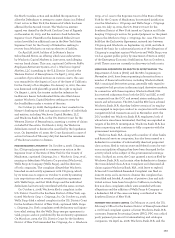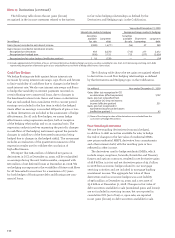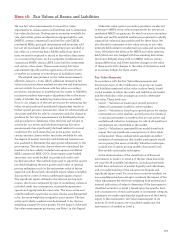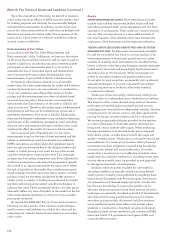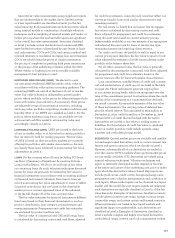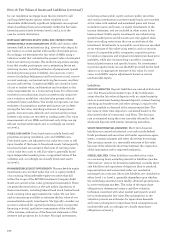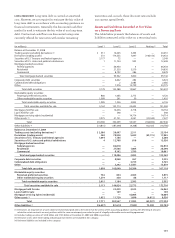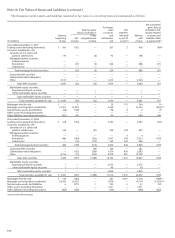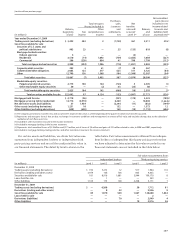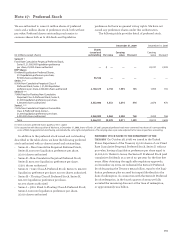Wells Fargo 2009 Annual Report Download - page 154
Download and view the complete annual report
Please find page 154 of the 2009 Wells Fargo annual report below. You can navigate through the pages in the report by either clicking on the pages listed below, or by using the keyword search tool below to find specific information within the annual report.
Assets
SHORT-TERM FINANCIAL ASSETS Short-term financial assets
include cash and due from banks, federal funds sold and
securities purchased under resale agreements and due from
customers on acceptances. These assets are carried at histori-
cal cost. The carrying amount is a reasonable estimate of
fair value because of the relatively short time between the
origination of the instrument and its expected realization.
TRADING ASSETS (EXCLUDING DERIVATIVES) AND SECURITIES
AVAILABLE FOR SALE Trading assets and securities available
for sale are recorded at fair value on a recurring basis. Fair
value measurement is based upon quoted prices in active
markets, if available. Such instruments are classified within
Level 1 of the fair value hierarchy. Examples include exchange-
traded equity securities and some highly liquid government
securities such as U.S. Treasuries. When instruments are
traded in secondary markets and quoted market prices
do not exist for such securities, we generally rely on internal
valuation techniques or on prices obtained from indepen -
dent pricing services or brokers (collectively, vendors)
or combination thereof.
Trading securities are mostly valued using trader prices
that are subject to independent price verification procedures.
The majority of fair values derived using internal valuation
techniques are verified against multiple pricing sources,
including prices obtained from independent vendors. Vendors
compile prices from various sources and often apply matrix
pricing for similar securities when no price is observable.
We review pricing methodologies provided by the vendors
in order to determine if observable market information is
being used, versus unobservable inputs. When evaluating
the appropriateness of an internal trader price compared
with vendor prices, considerations include the range and
quality of vendor prices. Vendor prices are used to ensure the
reasonableness of a trader price; however valuing financial
instruments involves judgments acquired from knowledge
of a particular market and is not perfunctory. If a trader
asserts that a vendor price is not reflective of market value,
justification for using the trader price, including recent sales
activity where possible, must be provided to and approved
by the appropriate levels of management.
Similarly, while securities available for sale traded in
secondary markets are typically valued using unadjusted
vendor prices or vendor prices adjusted by weighting them
with internal discounted cash flow techniques, these prices
are reviewed and, if deemed inappropriate by a trader who
has the most knowledge of a particular market, can be
adjusted. Securities measured with these internal valuation
techniques are generally classified as Level 2 of the hierarchy
and often involve using quoted market prices for similar
securities, pricing models, discounted cash flow analyses
using significant inputs observable in the market where
available or combination of multiple valuation techniques.
Examples include certain residential and commercial MBS,
municipal bonds, U.S. government and agency MBS, and
corporate debt securities.
Upon the acquisition of Wachovia, we elected to measure
at fair value certain portfolios of LHFS that we intend to hold
for trading purposes and that may be economically hedged
with derivative instruments. In addition, we elected to mea-
sure at fair value certain letters of credit that are hedged with
derivative instruments to better reflect the economics of the
transactions. These letters of credit are included in trading
account assets or liabilities.
Determination of Fair Value
In accordance with the Fair Value Measurements and
Disclosures topic of the Codification, we base our fair values
on the price that would be received to sell an asset or paid to
transfer a liability in an orderly transaction between market
participants at the measurement date. It is our policy to
maximize the use of observable inputs and minimize the
use of unobservable inputs when developing fair value
measurements, as prescribed in the fair value hierarchy.
In instances where there is limited or no observable
market data, fair value measurements for assets and liabilities
are based primarily upon our own estimates or combination
of our own estimates and independent vendor or broker
pricing, and the measurements are often calculated based
on current pricing policy, the economic and competitive
environment, the characteristics of the asset or liability and
other such factors. Therefore, the results cannot be determined
with precision and may not be realized in an actual sale or
immediate settlement of the asset or liability. Additionally,
there may be inherent weaknesses in any calculation technique,
and changes in the underlying assumptions used, including
discount rates and estimates of future cash flows, that could
significantly affect the results of current or future values.
We incorporate lack of liquidity into our fair value
measurement based on the type of asset measured and the
valuation methodology used. For example, for residential
MHFS and certain securities where the significant inputs
have become unobservable due to the illiquid markets and
vendor or broker pricing is not used, we use a discounted
cash flow technique to measure fair value. This technique
incorporates forecasting of expected cash flows (adjusted for
credit loss assumptions and estimated prepayment speeds)
discounted at an appropriate market discount rate to reflect
the lack of liquidity in the market that a market participant
would consider. For other securities where vendor or broker
pricing is used, we use either unadjusted broker quotes or
vendor prices or vendor or broker prices adjusted by weight-
ing them with internal discounted cash flow techniques to
measure fair value. These unadjusted vendor or broker prices
inherently reflect any lack of liquidity in the market as the fair
value measurement represents an exit price from a market
participant viewpoint.
As required by FASB ASC 825-10, Financial Instruments,
following are descriptions of the valuation methodologies
used for assets and liabilities recorded at fair value and for
estimating fair value for financial instruments not recorded
at fair value.
Note 16: Fair Values of Assets and Liabilities (continued)





